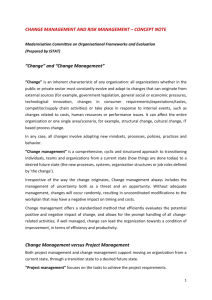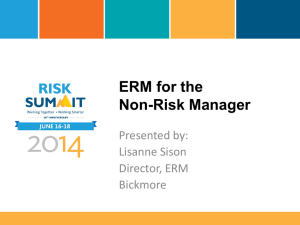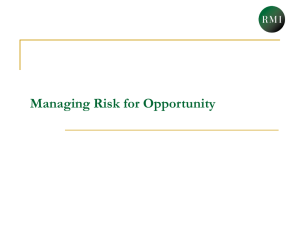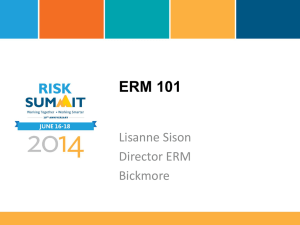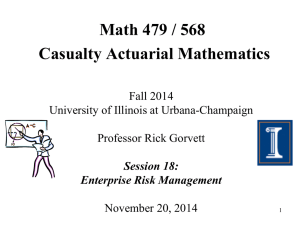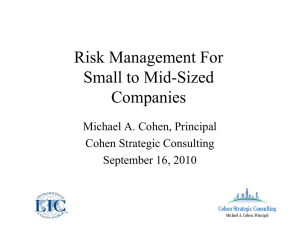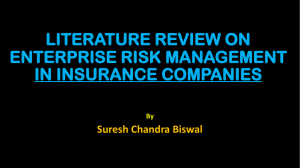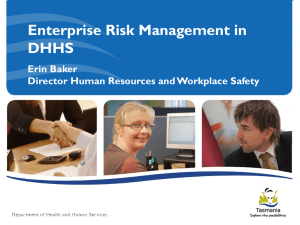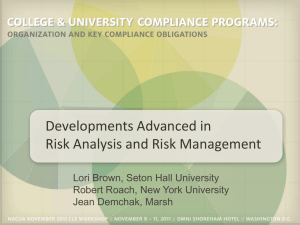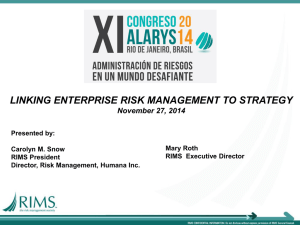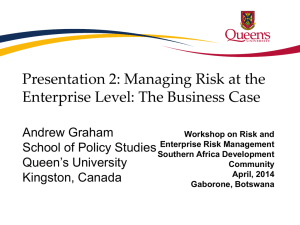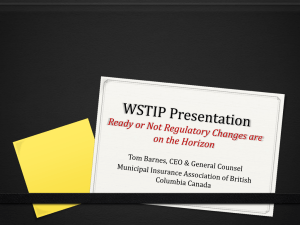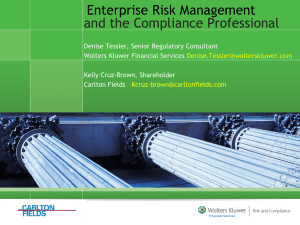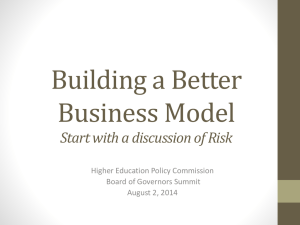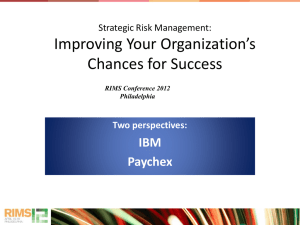Federal Enterprise Risk Management – Where is the Value?
advertisement
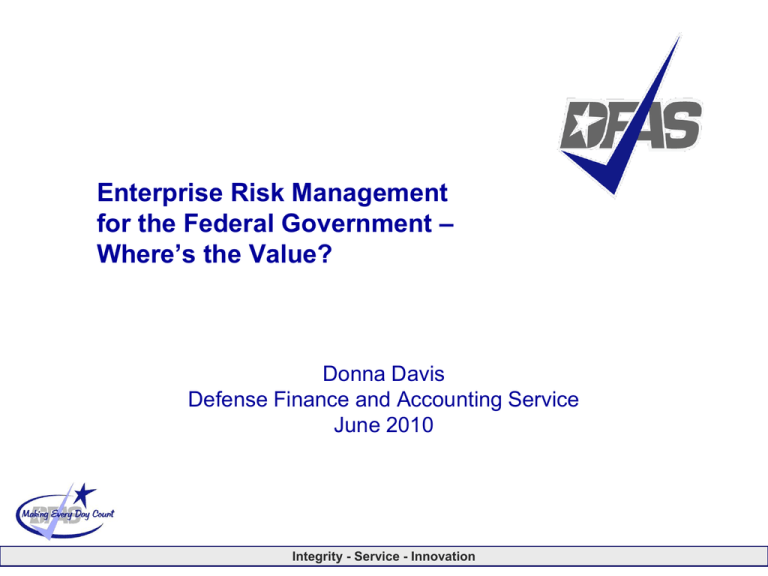
Enterprise Risk Management for the Federal Government – Where’s the Value? Donna Davis Defense Finance and Accounting Service June 2010 Integrity - Service - Innovation Agenda ERM - Where’s the Value? Putting the COSO Framework to Work in the Federal Sector Event Identification Risk Assessment Risk Response Control Activities Information and Communication Monitoring Some Pitfalls to be Wary of A Gallery of Tools and Techniques 4/13/2015 Integrity - Service - Innovation 2 ERM in the Federal Government – Where’s the Value Three Parts of Business Objective Risk Controls Objective Risk 4/13/2015 Control Integrity - Service - Innovation 3 ERM in the Federal Government – Where’s the Value Three Parts of Business Objective – what you are trying to accomplish Not For Profit To achieve a mission or objective while protecting assets. For Profit To maximize shareholder wealth or, in the case of a corporation, to maximize the value of the firm as measured by stock price. Realize a benefit from resources expended. Achieve goals and objectives for resources expended. Focus on efficiency. Focus on effectiveness. 4/13/2015 Integrity - Service - Innovation 4 ERM in the Federal Government – Where’s the Value Three Parts of Business Objective – what you are trying to accomplish Risk – the barrier that will stop you from accomplishing the objective Not For Profit Avoid Risk seeking safest path to mission achievement. For Profit Seek Risk as a means for expanding market value. Measure Value at Risk. Measure Impact of Risk on Goals and Objectives. 4/13/2015 Integrity - Service - Innovation 5 ERM in the Federal Government – Where’s the Value Three Parts of Business Objective – what you are trying to accomplish Risk – the barrier that will stop you from accomplishing the objective Controls – the action that will remove or diminish the risk For Profit Affect controls for the purpose of minimizing loss. 4/13/2015 Not For Profit Affect controls to assure compliance, accountability, effectiveness/efficiency, reliability of reported data and safeguarding assets. Integrity - Service - Innovation 6 ERM in the Federal Government – Where’s the Value What Do We Want From the “Business” of Government? 4/13/2015 To be Affordable and Efficient To be Effective To provide Quality Service To be Dependable Integrity - Service - Innovation 7 ERM in the Federal Government – Where’s the Value What Do We Want From the Business of Government? To be Affordable and Efficient To be Effective To provide Quality Service To be Dependable So – We need to be able to achieve the established mission in order to retain the confidence of our funders. We need to provide value for our services. Bottom Line – We need to meet our objectives and protect our assets, including intangible ones such as reputation. 4/13/2015 Integrity - Service - Innovation 8 ERM in the Federal Government – Where’s the Value What Value does ERM Provide? 4/13/2015 Supports Government’s Governance Responsibilities Improves Results Strengthens Accountability Enhances Stewardship Integrity - Service - Innovation 9 ERM in the Federal Government – Where’s the Value How does ERM support Government’s Governance Responsibilities? By ensuring that significant risk areas associated with polices, plans, programs and operations are identified and assessed. By ensuring that appropriate measures are in place to address unfavorable impacts and to benefit from opportunities. 4/13/2015 Integrity - Service - Innovation 10 ERM in the Federal Government – Where’s the Value How does ERM Improve Results ? Through more informed decision-making and by ensuring that values, competencies, tools, and a supportive environment form the foundation for innovation and responsible risk-taking. By encouraging learning from experience while respecting parliamentary controls. 4/13/2015 Integrity - Service - Innovation 11 ERM in the Federal Government – Where’s the Value How does ERM Strengthen Accountability? By demonstrating that levels of risk associated with policies, plans, programs and operations are explicitly understood. By facilitating the optimum balance in risk management measures and stakeholder interests. 4/13/2015 Integrity - Service - Innovation 12 ERM in the Federal Government – Where’s the Value How does ERM Enhance Stewardship? By strengthening public service capability to safeguard people, government property and interests through increased insight to the potential impact of abnormal events. 4/13/2015 Integrity - Service - Innovation 13 Putting the COSO Framework to Work in the Federal Sector DFAS-ization of COSO 4/13/2015 Integrity - Service - Innovation 14 Putting the COSO Framework to Work in the Federal Sector Internal Environment Objective Setting Event Identification Risk Assessment Risk Response Controls Activities Information & Communication Monitoring • DFAS ‘ ERM Philosophy and Methodology • Risk Taxonomy • Risk Polices and Standards • DFAS Mission • Strategic Objectives • Operational Objectives • Potential Events affecting Objective Achievement • Positive/Negative Impact • External/Internal Factors • Likelihood and Impact • Category of Impact • Response Options: Accept, Avoid, Mitigate, Share, etc. • Response Cost versus Benefit • Policies and Procedures • Control Activities: Approvals, Authorizations, Verifications, Reconciliations, Reviews, etc. • Timely ERM Communication Flow Up, Down and Across the Agency • Integration of Risk Information Across the Agency (Audit Findings, SITREPS, Self-Identified Deficiencies) • Internal and External • Training • Assessment of Presence and Functioning of ERM Components • Regular Control Testing and Reviews DFAS alignment to the Risk Components ensures a robust program and strengthens compliance with the GAO Standards for Internal Control. 4/13/2015 Integrity - Service - Innovation 15 Putting the COSO Framework to Work in the Federal Sector Compliance Accountability (Strategic) Reliability (Reporting) Effective and Efficient (Operations) Safeguard Assets • With Federal Regulations and Laws • With DFAS Regulations and Polices • With Operational Policies and Procedures • For Achievement of Strategic Objectives and desired outcomes • For Achievement of Operational Objectives and desired outcomes • For use of public resources • Provide reliable, useful and timely information • Accurate and timely recoding of transactions and events • Carryout public functions legally, effectively, efficiently, economically, ethically, and equitably • Access restrictions to and accountability for resources and records • Segregation of duties DFAS expanded the Risk Management Objectives to address data security concerns and general auditing standards. 4/13/2015 Integrity - Service - Innovation 16 Putting the COSO Framework to Work in the Federal Sector Agency Cycle Cycle Program • DFAS • Business • Enabling • Governance • Payroll Disbursements Mngt • Other Disbursements Programs • Revenue & Receipts Execution • Assets & Liabilities • Financial Reporting Personnel Customer Relation Procurement Mgt of Processes & Provide IT Support Strategic Planning & Infrastructure Finance & Budget • 63 Programs - Business Functions (Mil Pay, Accounts Payable, Budget, ERM, etc.) Functions • A group of related actions (Payroll Record Maintenance, Process Payroll, Certify Payroll, etc.) Processes • A series of tasks or operations conducing to an end ( Input data, edit data, validate entry, save data, etc.) Level 3 Maps • Detailed steps for accomplishing a task Stratification across business units and at every level of the organization was applied to enable accurate reflection of the interrelationships of risks and create a common taxonomy for business activities. 4/13/2015 Integrity - Service - Innovation 17 Putting the COSO Framework to Work in the Federal Sector Agency Cycle Cycle Program • DFAS • Business • Enabling • Governance • Payroll Disbursements Mngt • Other Disbursements Programs • Revenue & Receipts Execution • Assets & Liabilities • Financial Reporting We are actually finding this layer adds little value as we evolve the program. Personnel Customer Relation Procurement Mgt of Processes & Provide IT Support Strategic Planning & Infrastructure Finance & Budget • 63 Programs - Business Functions (Mil Pay, Accounts Payable, Budget, ERM, etc.) Functions • A group of related actions (Payroll Record Maintenance, Process Payroll, Certify Payroll, etc.) Processes • A series of tasks or operations conducing to an end ( Input data, edit data, validate entry, save data, etc.) Level 3 Maps • Detailed steps for accomplishing a task Stratification across business units and at every level of the organization was applied to enable accurate reflection of the interrelationships of risks and create a common taxonomy for business activities. 4/13/2015 Integrity - Service - Innovation 18 Some Pitfalls to be Wary of Trying to risk manage EVERYthing Just focusing on financial risks An obsession with internal controls – an inward looking limitation 4/13/2015 Integrity - Service - Innovation 19 A Gallery of Tools and Techniques Agency Mission and Functions Manual Provides the business objectives COSO Framework Identifies a comprehensive view of the elements of a robust ERM A Catchy Logo CARES – covers the five Risk Management Objectives DFAS assesses Compliant Accountable Reliable & Accurate Effective & Efficient Safeguarded 4/13/2015 Integrity - Service - Innovation 20 A Gallery of Tools and Techniques SIPOC Model Guides process mapping through a complete end to end review of the factors impacting the business activity 4/13/2015 Integrity - Service - Innovation 21 A Gallery of Tools and Techniques IDEF Model Denotes the role of compliance/regulations/controls in the business activity Denotes the role of the supporting mechanisms for the business activity Integration DEFinition Model 4/13/2015 Integrity - Service - Innovation 22 A Gallery of Tools and Techniques Risk Identification Questionnaire Facilitates comprehensive and consistent assessment of potential risks 1. Policies, procedures, plans, laws, and regulations are complied with; 1. What laws are applicable to your group? A. What is the risk if laws are not followed? 2. What regs are applicable to your group? B. What is the risk if regs are not followed? 3. What procedures (SOPs) are applicable to your group? C. What is the risk if procedures are not followed? 4. What management policies are applicable to your group? D. What is the risk if management policies are not followed? Economically: 1. Do you have a program budget? 2. Are you responsible for aquiring products or services? 3. Are you making decisions regarding best use of government (taxpayer resources)? What are your risks if these resources are not used in an economical manner? Fraud, Waste, Abuse, etc? Efficiency: 1. Guidelines (policies or regs) that dictate timeliness? 2. Deliverables on budget, on time? 2. Resources are used and procedures are performed in an economical and efficient manner; and What are the risks if these efficiency guidelines are not met? Courtesy of Brian Williams 4/13/2015 Integrity - Service - Innovation 23 A Gallery of Tools and Techniques Process Map & Narrative For business processes For Information Systems data flow Transfer bond data to DCPS <CSR> <OPM MyPay <Savings Bonds Enter bond data online to DCPS Review Bond Reports <DFAS 2 4 1 DCPS Issue Bond Detail File Bond Reports Bond Issuing Agency> 3 4/13/2015 Receive Issue Bond Detail File Integrity - Service - Innovation 24 End Questions? 4/13/2015 Integrity - Service - Innovation 25
